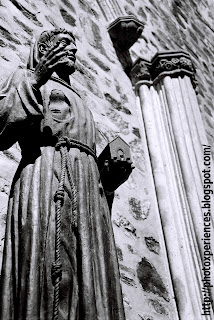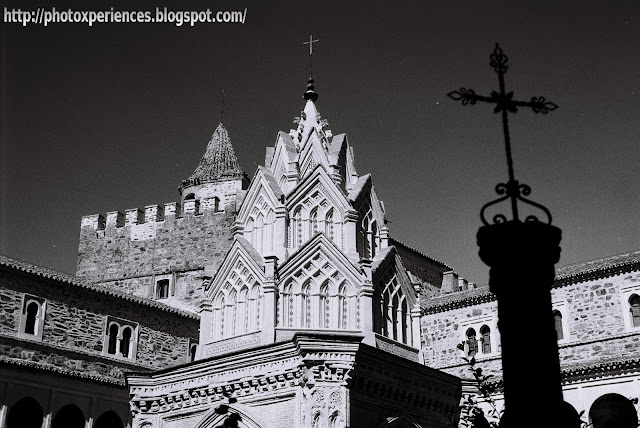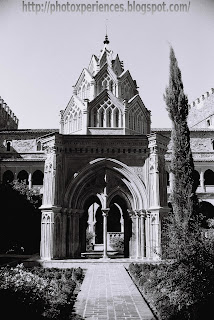 Guadalupe es una población española, situada en la comarca de las Villuercas de la provincia de Cáceres (Comunidad Autónoma de Extremadura). Fue fundada en el siglo XIII, y cuenta actualmente con 2.000 habitantes.
Guadalupe es una población española, situada en la comarca de las Villuercas de la provincia de Cáceres (Comunidad Autónoma de Extremadura). Fue fundada en el siglo XIII, y cuenta actualmente con 2.000 habitantes.
Guadalupe is a Spanish municipality, located in the region of Las Villuercas of the province of Cáceres (Autonomous Community of Extremadura). It was founded in the thirteenth century, and currently has 2,000 inhabitants.
 Debe su nombre al río Guadalupe, que discurre cerca de la población. El origen de este nombre procede el árabe Was-al-luben, que significa río escondido. Hay quien defiende que la palabra es un híbrido de Wad-al (río en árabe) y lupus (lobo en latín), pero es una interpretación menos sostenible.
Debe su nombre al río Guadalupe, que discurre cerca de la población. El origen de este nombre procede el árabe Was-al-luben, que significa río escondido. Hay quien defiende que la palabra es un híbrido de Wad-al (río en árabe) y lupus (lobo en latín), pero es una interpretación menos sostenible.
It owes its name to the Guadalupe River, which runs near the village. The origin of this name comes from the Arabic Was-al-Luben, meaning hidden river. Some argue that the word is a hybrid of Wad-al (river in Arabic) and lupus (wolf in Latin), but this is a less tenable interpretation.
 Podemos encontrar, entre sus preciosas calles con típicos soportales de madera y balcones floridos, numerosos e interesantes monumentos: el Colegio de Infantes, la Enfermería de Monjes, el Hospital de San Juan Bautista, el Hospital Nuevo, el Hospital de San Juan, donde en 1442 se practicó por primera vez en España la cirugía y la disección por cirujanos frailes y seglares, la Iglesia de la Santa Trinidad, varios arcos de la muralla medieval, y la antigua judería que se ubica alrededor de la Plazuela de los Tres Chorros. Y entre todos ellos sobresale el Real Monasterio de Santa María de Guadalupe.
Podemos encontrar, entre sus preciosas calles con típicos soportales de madera y balcones floridos, numerosos e interesantes monumentos: el Colegio de Infantes, la Enfermería de Monjes, el Hospital de San Juan Bautista, el Hospital Nuevo, el Hospital de San Juan, donde en 1442 se practicó por primera vez en España la cirugía y la disección por cirujanos frailes y seglares, la Iglesia de la Santa Trinidad, varios arcos de la muralla medieval, y la antigua judería que se ubica alrededor de la Plazuela de los Tres Chorros. Y entre todos ellos sobresale el Real Monasterio de Santa María de Guadalupe.
We can find many interesting mouments among its beautiful streets with typical wooden porches and balconies with flowers: the Infants College, the Monks Nursing, the Hospital of St. John the Baptist, the New Hospital, the Hospital of San Juan, where in 1442 was performed for the first time in Spain a dissection surgery, the Church of the Holy Trinity, arches of the medieval wall, and the old Jewish quarter that is located around the Square of the Three Jets. And between them stands the Royal Monastery of Santa Maria de Guadalupe.


El Monasterio acoge la estatua de la Virgen de Guadalupe. Esta Virgen tiene una importancia notable ya que se convirtió en un poderoso símbolo de la cristianización de gran parte del Nuevo Mundo. Si bien el monasterio estuvo habitado en un principio por monjes jerónimos (siglos XIV-XV), actualmente está regentado por franciscanos.


The monastery houses the statue of the Virgin of Guadalupe. This Virgin has a significant importance as it became a powerful symbol of the Christianization of much of the New World. Although the monastery was inhabited initially by Hieronymite monks (XIV-XV centuries), it’s currently run by Franciscans.

 Está construida sobre el emplazamiento de una antigua ermita de finales del siglo XIII. A ésta le sucedió una iglesia de estilo mudéjar (siglo XIV), y la actual fue edificada en 1403, realizándose sucesivas ampliaciones hasta el siglo XVIII. Ello hace que en el conjunto del monasterio podamos observar elementos mudéjares, góticos, renacentistas, barrocos y neoclásicos.
Está construida sobre el emplazamiento de una antigua ermita de finales del siglo XIII. A ésta le sucedió una iglesia de estilo mudéjar (siglo XIV), y la actual fue edificada en 1403, realizándose sucesivas ampliaciones hasta el siglo XVIII. Ello hace que en el conjunto del monasterio podamos observar elementos mudéjares, góticos, renacentistas, barrocos y neoclásicos.
It’s built on the site of an ancient shrine of the late thirteenth century. Later there was a Mudejar style church (XIV century), and the current one was built in 1403, going through successive enlargements until the eighteenth century. This means that on the whole monastery we will observe Moorish, Gothic, Renaissance, Baroque and Neoclassical elements.
Dentro del conjunto monumental que integra el Monasterio destacan la Iglesia gótica de Nuestra Señora (siglo XIV), con retablo y decoración barroca; el Camarín de la Virgen con pinturas de Luca Giordano; la Sala Capitular; la Sacristía y Capilla de San Jerónimo, con cuadros famosos de Zurbarán; el Comedor de la Hospedería; el Museo de Bordados (en el antiguo refectorio); sus Museos de pintura y escultura, con obras de Juan de Flandes, Zurbarán, Goya, y el Greco, entre otros; y el Museo de libros miniados, situado en el claustro mudéjar y que alberga una colección de grandes libros de coro miniados de los siglos XV-XVI provenientes del scriptorium del propio monasterio y considerada entre los mejores del mundo; y un Claustro gótico. Todo este conjunto está fortificado y rodeado por ocho torres defensivas entre las que destacan las de Santa Ana, la de Portería y la de las Campanas.
 Among the monuments that integrates the monastery it’s included the Gothic Church of Our Lady (XIV century), with Baroque decoration and altarpiece; the Chapel of the Madonna, with paintings of Luca Giordano; the Chapter House; the Sacristy and the Chapel of St. Jerome, with famous paintings by Zurbarán; the Dining Room of the Guesthouse; the Embroidery Museum (in the old refectory); its museums of paintings and sculpture, including works by Juan de Flandes, Zurbarán, Goya, and El Greco, among others; the Museum of illuminated books, which houses a collection of large illuminated choir books of the XV-XVI from the scriptorium of the monastery itself, considered among the best in the world; and the Gothic cloister. This set is fortified and surrounded by eight defensive towers among which are those of St. Anne, the Porter tower, and the Bells tower.
Among the monuments that integrates the monastery it’s included the Gothic Church of Our Lady (XIV century), with Baroque decoration and altarpiece; the Chapel of the Madonna, with paintings of Luca Giordano; the Chapter House; the Sacristy and the Chapel of St. Jerome, with famous paintings by Zurbarán; the Dining Room of the Guesthouse; the Embroidery Museum (in the old refectory); its museums of paintings and sculpture, including works by Juan de Flandes, Zurbarán, Goya, and El Greco, among others; the Museum of illuminated books, which houses a collection of large illuminated choir books of the XV-XVI from the scriptorium of the monastery itself, considered among the best in the world; and the Gothic cloister. This set is fortified and surrounded by eight defensive towers among which are those of St. Anne, the Porter tower, and the Bells tower.
Entre todas sus dependencias destaca el magnífico Claustro de los Milagros, de estilo gótico mudéjar. Fue construido entre por fray Juan de Sevilla 1389 y 1405. Se compone de dos plantas de forma rectangular, que dan paso a los dormitorios y el refectorio. En sus paredes se expone una colección de cuadros relacionados con los milagros de la Virgen.

We can find, among all its dependencies, the magnificent Cloister of Miracles, of Mudejar Gothic style. It was built by Fray Juan de Sevilla from 1389 to 1405. It consists of two rectangular floors, that lead to the bedrooms and refectory. On its walls it’s exposed a collection of pictures related to the miracles of the Virgin.
Cuenta con un pequeño templete en su centro, construido con barro cocido y ladrillo, decorado con azulejos y yeserías, y coronado con una flecha de cerámica blanca y verde, que se prolonga en un cruz de hierro.


It has a small temple at its center, built with clay and brick, decorated with tiles and plasterwork, and crowned with an arrow with white and green ceramic, which is extended by a cross of iron.
 Este monasterio fue en 1486 el escenario del encuentro entre Cristóbal Colón y los Reyes Católicos para que éstos financiaran el viaje a las Indias. En 1492, cuando la reina Isabel la Católica acudió al monasterio para dar las gracias por la rendición de Granada, tomó la decisión de hacer entrega a Colón de dos carabelas. Éste, en su primera expedición a América se encomendó a la Virgen de Guadalupe y le dio su nombre a una isla del Caribe.
Este monasterio fue en 1486 el escenario del encuentro entre Cristóbal Colón y los Reyes Católicos para que éstos financiaran el viaje a las Indias. En 1492, cuando la reina Isabel la Católica acudió al monasterio para dar las gracias por la rendición de Granada, tomó la decisión de hacer entrega a Colón de dos carabelas. Éste, en su primera expedición a América se encomendó a la Virgen de Guadalupe y le dio su nombre a una isla del Caribe.
In 1486 this monastery was the scene of the encounter between Christopher Columbus and the Catholic Monarchs in order to study the inversion of the voyage to the Indies. In 1492, when Queen Isabella went to the monastery to give thanks for the surrender of Granada, she made the decision to hand over two caravels to Columbus. This one, on his first expedition to America, was entrusted to the Virgin of Guadalupe and gave its name to a Caribbean island.


Por todo lo expuesto, la Unesco decidió en 1993 inscribir el Monasterio de Guadalupe en la lista del Patrimonio de la Humanidad.


Una visita guiada llena de detalles. Saludos.
ResponderEliminarMuchas gracias, Antonio. Saludos.
Eliminar